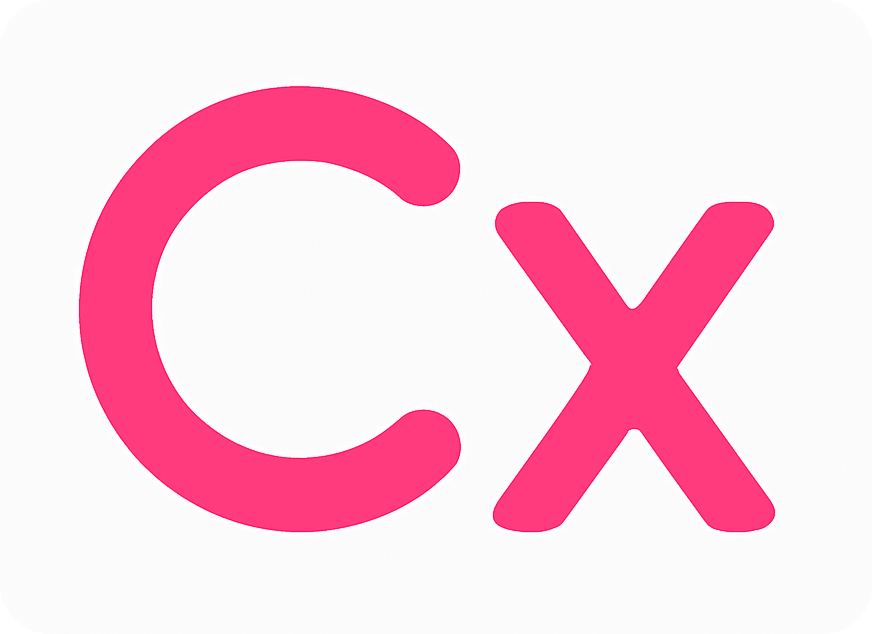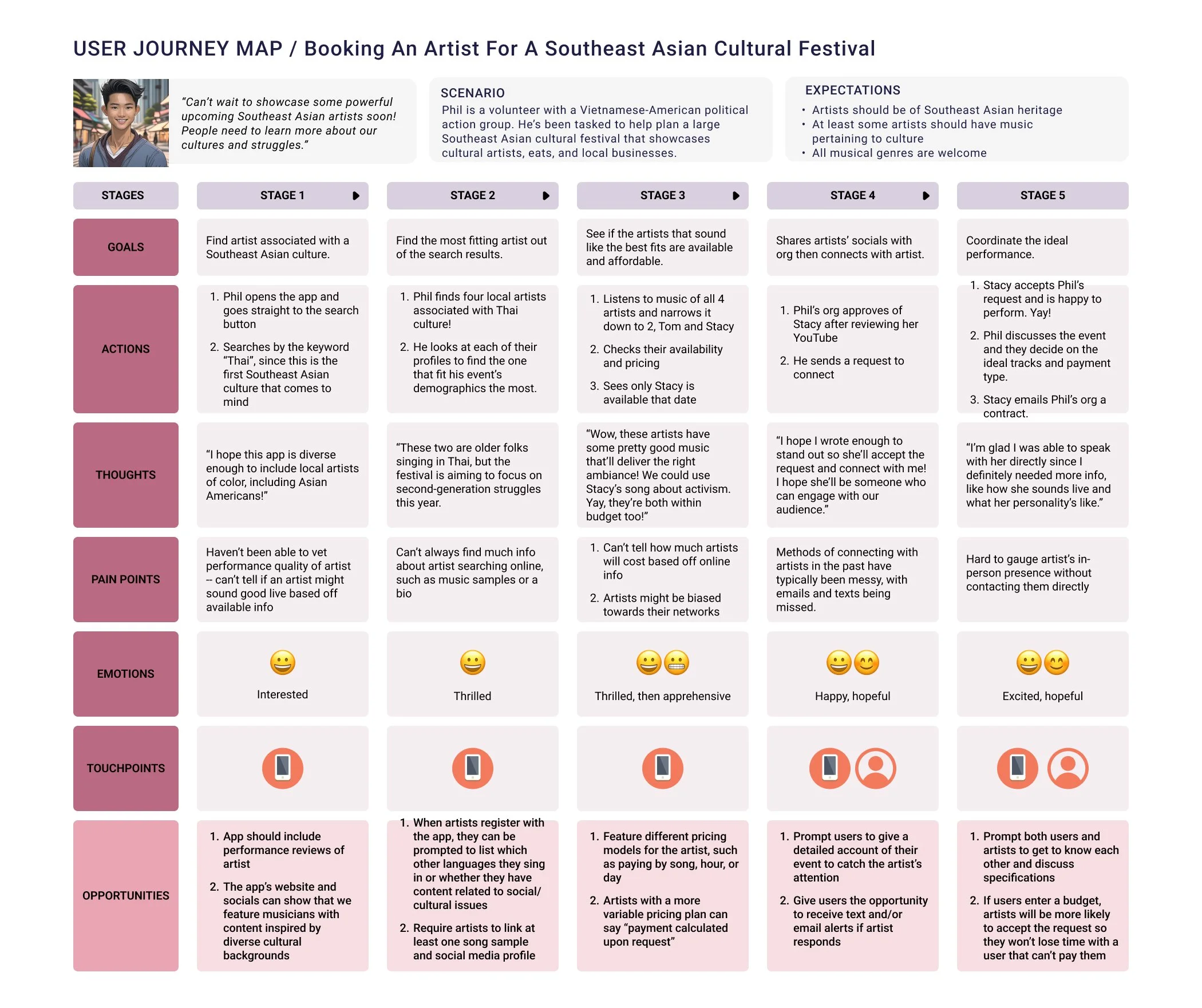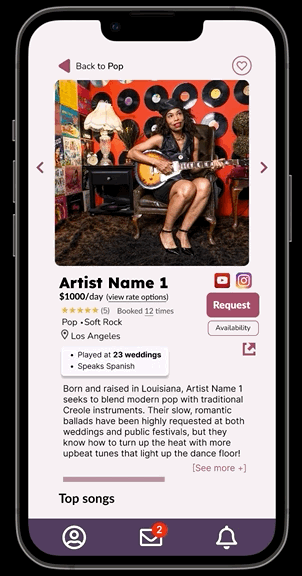📅 July 2025 | 👩💻 UX designer/researcher, software developer | 🛠 Figma, Lovable
💼 original product designed and developed for future acquisition
Find a free, public space to work remotely from.
Remote Rover is a tool I designed and built to help people find free, work-friendly public spaces, particularly cafes, libraries, hotel lobbies, and food courts with reliable Wi-Fi.
As someone who has worked remotely in several countries and states, I wanted to streamline the process of finding appropriate spaces so users aren’t sifting through too much data and ask locals “where can I work from?” on discussion forums, only to end up at Starbucks yet again.
That’s why Remote Rover exclusively features work-friendly locations. Discover locations that suit your needs and preferences, whether it’s being pet-friendly, quiet, near public transportation, and more.
😀 Solution: Remote Rover simplifies the search for remote work-friendly spaces by providing a curated, searchable map of cafes, libraries, and more with reliable Wi-Fi, saving users time and discovering laptop-friendly spots.
Intended project impact:
Remote Rover enables users to work more flexibly by removing the friction of finding reliable, free remote workspaces. It helps users discover new, underutilized locations — boosting foot traffic for independent cafes, libraries, and other venues that support remote work.
This can have a positive impact on the employers of such remote workers: discovering more suitable environments to work from can support productivity and work-life balance. By surfacing hidden gems and reducing decision fatigue, Remote Rover contributes to a more distributed, accessible, and adaptable remote work ecosystem for all.
😩 Problem: Finding remote work-friendly spaces is tedious: users must sift through reviews and photos on Google Maps, and new or lesser-known locations often lack clear signals of laptop suitability.
⚠️ The prototype currently uses placeholder data due to high API costs, but the structure is built for scale.
The significance and impact of live music:
It would be a dream to book Beyoncé to light up your local pizza festival and wow your whole city, but this is probably out of your league (for now 😉). Most everyday events, such as weddings, festivals, fairs, carnivals, tend to hire smaller, local musicians that won’t cost a few body parts but can still deliver an engaging, exciting, talented performance to liven up the atmosphere.
Why not just play recorded audio? Well, studies show that there are physical and mental health benefits to experiencing live music:
Stimulating oxytocin and dopamine
Gathering with other people in person fosters a sense of social connectedness, especially if the musicians engage with the audience and come from the same community
Facilitating networking and socializing among attendees
The common interest in the music can serve as a conversation starter and icebreaker
Draws publicity to the artist, venue, community, and event
“How might we build a tool to help people and businesses enhance their event’s ambiance and fulfill their objective with live music?”
🛣 A deeper look into the journey of finding workspaces online
I began my user research with secondary research on the process of finding remote workspaces online.
This is how users typically find spaces so far:
Google searches for “where to work remotely” that turn up articles from various publications with titles like 29 SF Coffee Shops For Getting Work Done
Asking “Favorite cafes to work from” on discussion forums such as Reddit
Searching Google Maps with keywords like “coffee shops with wifi”, then sifting through photos, reviews, and other details to assess if needs and wants are present such as a quiet atmosphere AND strong wifi
Asking people you know
💼 📈 Taking business needs into account: This product doesn’t just impact users, but also the businesses who are likely to receive increased traffic.
Taking this into account, I reviewed the potential impact of Remote Rover on business operations as depicted in this discussion, such as potential issues and profitability. The overall takeaway seems to be that while Remote Rover is likely to increase the amount of patrons who use such spaces without contributing to sales, increasing traffic is likely to lead to greater net profits overall.
“The problem is not finding musicians that want to play, the problem is finding musicians that will be a draw enough people to make the event successful at a price the promoter/venue can afford.”
⚠️ Possible biases and constraints to consider
A designer creating an app for event coordinators to book live musicians may face challenges due to personal biases. In designing this, I wanted to note a possible potential limitation: my own limited experience in attending music with live events, including my lack of interest in much of the live music being featured.
Most events I’ve attended with live music were often community events intended to bolster support for a marginalized community, thus prospective users in such situations would have distinct needs that other users may not have, and vice versa. Unsurprisingly, most users who I surveyed for this project also had only booked musicians for smaller, communal events such as weddings and fundraisers.
This bias can lead to an app that doesn't fully address the needs of a broader range of events, such as corporate functions, or private parties. I did some research on how to mitigate this bias and decided to ensure that I was not limiting my range of events to my personal experiences, which meant empathizing with user journeys that differed from what I was familiar with. I also used ChatGPT to help create unfamiliar personas and user journeys.
👩💻 So what do users and businesses look for in the right musicians? What are their goals?
Below is a summary of typical (user and business) needs and concerns I discovered through secondary and primary user research.
🙁
It seemed like most users were currently using social media or established industry connection to book artists rather than apps like this, so I unfortunately found little information about the details of current tool usage beyond social media and emails.
🎶 Artist sound + image
How the band sounds live — just because their music sounds beautiful doesn’t mean they can perform well!
Confident, engaging, friendly stage presence — or whatever persona the event needs them to be, be it warm or brooding.
Their sound and personality should be appealing to the target audience, not just the event producers
Does the artist's image reflect the company's values and brand message?
🚙 Logistics
Does the venue have size and capacity for the artist's stage setup and equipment needs?
Is the artist available on the event date, and does their tour schedule allow for travel and setup time?
How close is the artist to my event? If the artist isn't local, consider travel expenses and potential logistical issues.
Will the artist have any logistical requirements from us?
💸 Expenses
What’s the event budget?
Is the artist charging by hour? Song? Project?
Are there any fees outside of their usual rates?
Will the artist need any other accommodations?
What happens if the artist has to cancel?
🤔 Other
Would a well-known artist generate more excitement, or would a lesser-known, talented band be more cost-effective?
If the artist has a professional website, social media presence, and good communication skills, it’ll make the researching and hiring process smoother
🔍 A more in-depth look at our prospective users
I used the information above to put together user personas and a journey map featuring common but diverse user journeys and needs, taking into account a wide range of events contrasting in theme and cultural background.
The main two user personas I designed the user flows around were:
Professional event coordinators
People of any background putting together private events, such as weddings.
💼📈 Taking business needs into account: The following two personas are hiring musicians on behalf of organizations, thus their user needs reflect their organization’s needs of improving the organization’s reputation, increasing revenue, maintaining organized records, promoting their community, and more.
👩💼 What are our hypothetical competitors like?
What are some other platforms our users above may have tried? I reviewed 10 other musician marketplace platforms to note what features they include, their positives and negatives, as well as to derive inspiration for this app.
Common useful features I found that align with my aforementioned user and business needs are:
✅ # of verified previous bookings
✅ artist location
✅ reviews with 1-5 star ratings on the search results
✅ starting prices + pricing packages
✅ availability check
✅ genres identified with
✅ languages spoken
✅ pricing packages
✅ # of years active
✅ whether they’re a band or just one artist, if band then names of members
🤔 How might we fulfill these user needs and goals with design?
Our user goals:
To know what the artist sounds like live ➡️
To know the artist’s overall branding ➡️
To know how an artist charges ➡️
To know the artist’s behavior when performing ➡️
More consolidated, less scattered info on artist across multiple disparate sources ➡️
A search engine that organizes artists by factors users often look for such as genre and location ➡️
✨
Possible design opportunities:
Sections for artist audio and/or video
Profile should feature multiple photos
A section that lists multiple pricing options
Social proof, like a section for reviews from other users
A detailed profile section that includes years of experience, genre, and more
Search results inspired by Google search results that tag artist rating, genre, and other key highlights
🔁 2024 revision: Incorporating generative AI
To leverage the power of generative AI to assist with this project, I asked ChatGPT to pose as an extra user. To account for the biases mentioned above, I specifically chose an older persona who was not well-represented in my research.
The prompt was:
“Now imagine that you're a 50-year-old COO of a major tech corporation. The company is putting on its own 3-day conference that'll have employees flying in from several states. You're looking for 2 rock bands local to the area of the conference to perform at the outdoor dining area during lunchtime and dinnertime. More specifically, you're looking for cover bands who can play rock covers of popular hit songs from the 1990s and early 2000s. You're looking to turn your conference's mealtimes into nostalgic dance parties. The band members should be warm, friendly, and entertain the audience members who are mostly eating. It's important they keep the performances lighthearted without making controversial statements. Once you identify the bands, you'll be handing the coordination to an event coordinator. What will you expect an app to find and book such musicians to deliver? What would make such an app easy to use?”
The mockups below incorporate some of ChatGPT’s feedback (which should NOT be held as equivalent to human user feedback) 👇
📝 Mockups: searching for an artist, then contacting them
While a successful performance depends on several factors, for this project I decided to focus on the user journey of identifying the right artist and the initial outreach.
😫 Challenges: Throughout the design process, I had to figure out how to accommodate the crucial information above without overwhelming the user and causing too much cognitive overload.
Note: Though only a mobile version has been designed, I acknowledge this app should be used on desktops 💻 as well.
Sample flow: searching by genre and location
I assembled as much of the information the users above seek out most to decide on an artist: location, rates, availability, bio, and notable accomplishments and other details. This snapshot ensures the user views critical details as quickly as possible without switching apps or windows.
To minimize back-and-forth clicking, I included a feature for users to be able to play samples of the artist’s featured songs directly in the app.
To deliver social proof to users, I included clear sections for reviews and previous bookings.
Searching for artists
Users can also search for artists across genres using a similar mental model as a streaming service search.
The UI of the search results was inspired by the UI of Netflix, colorfully describing the selection to quickly convey an artist’s general vibe.
Messaging artists
To minimize the cognitive load of organizing artist emails in the user’s general email inbox, I designed in-app messaging to help the user stay organized. Users still have the option to receive messages in their general email inbox.
Sending a request to connect with the artist
To ensure artists only receive requests from users more serious about booking, users are required to fill out a form. The form fields capture critical details about the organizer’s needs to minimize back-and-forth questioning between them and the artist.
The information provided also allows the artist to make a quicker, informed judgement on which organizer to accept connecting with.
📊 Hypothetical KPIs
🤔 To measure the success of this product, I would look at:
amount of user signups
amount of musicians contacted per user
amount of musicians booked by user
search completion time
how often users refine their searches
most and least-used filters and types of search terms (genre, style, community, sound, mood, etc)
amount and content of booking error/support tickets
user reviews, especially feature complaints and requests
referral rate
average booking value
the percentage of new users who successfully complete a booking within a specific time frame
🏆 Hypothetical wins would look like:
users reducing the overall time they spend finding the right musician, as well as reducing the time spent in the overall cycle of hiring and completing the payment
users praising in the reviews “this made it so much easier to find the right person who align with my organization’s values!”
users acknowledging and praising redesigns that improved their user experience in any way such as “I’m glad they added a feature for showing other venues the artist has performed at!”
an increasing growth in the percentage of artists booked per user or completion of the booking cycle/decrease in user abandonment
artists gradually increasing how often other artists to join the platform
an increasing rate in user satisfaction with the band’s performance, which indicates truly finding the right fit beyond the initial search
🤔 Hypothetical future considerations
If I were to further build this product with unlimited resources, I would:
Test it on users from an even wider variety of event planning backgrounds, including professional event planners. This would include card sorting exercises to better understand other ways users might seek artists.
Perform user research that takes wider accessibility needs into account
A/B test multiple versions of the same flows and page designs
Perform further user testing on other flows beyond just finding an artist, such as setting up the performance.
Heuristic reviews by other designers
Interview artists who would be featured on the platform about the booking journey from their perspective, create empathy maps
Build and test features for users to report unwanted, inappropriate behavior by artists and for artists to report such user behavior as well
Figure out ways to further refine search accuracy for users to further reach the objective stated above of finding the right artist
Come up with edge cases, such as some pretty bad conflict between an artist and an organizer
Test it for the KPIs mentioned above
…and much more!














